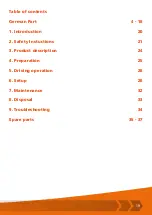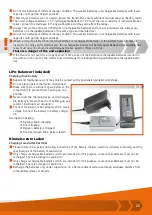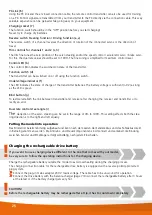
28
Control function of speed control system
Put the accelerator/brake lever and the respective trimming in the neutral position.
When the remote control lever is in the neutral position, the motor must not start up.
If necessary, bring the motor to a standstill using the trim on the transmitter.
Move the accelerator/brake lever on the remote control forward. The rotating speed of the motor should
change infinitely variably.
Then move the remote control lever backwards to check brake and reverse travel mode.
If the wheels turn in the wrong direction, use the servo reverse switch on the transmitter to correct the run-
ning direction.
5. Driving operation
Comply with the safety instructions in these Operating Instructions for driving operation.
Familiarise yourself with the driving behaviour of the model step-by-step.
Stand behind the model and first drive it away from you. The reaction of the model to the steering will then
be the same as if you were sitting at the wheel yourself.
Then make the model drive toward you. The direction in which it reacts is then mirror-reversed to the direction
of control.
Then begin with simple driving exercises by driving in an „eight“ pattern, forming circles as equal to one ano-
ther as possible.
Use lightweight cones that are not fastened as limits and turn markers to mark out a course with changing
directions to drive in so as to practice making curves.
Gradually increase the speed and observe the handling. Always maintain direct eye contact with the model.
6. Setup
Adjusting the shock absorbers
With the factory-adjustment of the model, you can get initial experience with no problem. With increasing driving
practice, however, depending on the course and condition of the ground, you will want to make customised adap-
tations step by step.
Ways of doing so include changing the spring preload and changing the angle of attack of the shock absorbers.
There is no universal specification for the spring preload or the angle of attack of the shock absorbers.
The adjustment of the shock absorbers has a crucial influence on the handling of the model. This not only affects
the actual absorption of the unevenness of the ground, but also of the steering via the grip of the individual axles.
Thus one speaks of, for example, „oversteering“ and „understeering“ handling.
Understeering handling:
The model has too much traction by the rear axle or too little traction by the front axle steered and can only be
turned on curves with difficulty. It „pushes“ outward over the front wheels.
As a countermeasure, the shock absorption in the front should be adjusted with less resistance (or more resis-
tance in the rear).
Oversteering handling:
The model has too little traction by the rear axle or too much traction by the front axle steered and „pulls“ in
curves, the rear tending to swerve out. As a countermeasure, the shock absorption in the rear should be adjusted
with less resistance (or more resistance in the front).
Structure of the shock absorbers
The spring elements for the suspension each consist of one linear flat coil spring, in the centre of which there is
an oil-pressure shock absorber. The flat coil springs bear upwards against a knurled nut on the outer tube of the
shock absorber and a plate on the lower end of the piston rod. The four shock absorbers are fastened on the
bottom wishbones and on the shock absorber bridge on the differential housings.
!













































